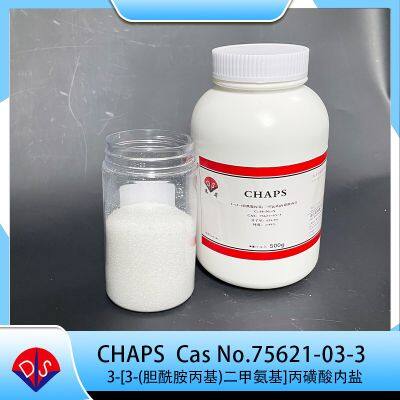Home > Products > Biological buffer > You can't help but know about the applications of CHAPS buffer
You can't help but know about the applications of CHAPS buffer
500 - 999 Kilogram
1000 - 4999 Kilogram
≥5000 Kilogram
- 10000 Kilogram / Kilograms per Month
- Shanghai
- T/T L/C PayPal Western Union
- 5 days
You May Like
-
Introduction and Application of Biological Buffer BIS Tris Propane 64431-96-5
-
Biological buffer piperazine-1,4-diethylsulfonic acid monosodium salt PIPES-NA basic information
-
Exploration of Buffer Performance and Stability of PIPES-K2 108321-27-3
-
2- (N-morpholine) ethanesulfonic acid monohydrate MES monohydrate
-
Characteristics and Use of TES Chemical Reagent as a Biological Buffer
-
The importance of BIS-TRIS HCl in electrophoresis, extraction, separation, and purification processes
Product Details
| CAS No. | 75621-03-3 | Source | Concrete | |
| Application | Scientific Research | Usage | Laboratory Reagents, Analytical Reagents, Diagnostic Reagents | |
| Specific Usage | For Biological Purpose | Content | Other, 99 | |
| Habit Appellation | Chemical Medicine | Property | Biochemical Reagent | |
| Classification | High Purity Material | Grade | AR | |
| Transport Package | carton | Specification | 500g/bottle | |
| Trademark | DS | Origin | China |
Product Description
In the fields of biochemistry and molecular biology, buffering agents play an important role in maintaining the stability of experimental systems and ensuring the integrity of biomolecules. CHAPS, as a type of biological buffer, has a CAS number of 75621-03-3 and a molecular formula of C ∝? H ?? N ? O ? S. From its chemical structure, it is a substance that combines the useful properties of sulfobetaine type and bile salt detergent. At room temperature, CHAPS appears as a white powder solid. Its good water solubility (50mg/mL) makes it easy to operate and prepare solutions in experimental applications, which also gives it a favorable position in many application fields.
Application of CHAPS in membrane protein related research
1. Dissolved membrane proteins: The study of membrane proteins has always been one of the key and difficult points in the field of biochemistry. CHAPS, as a non denaturing stain remover, has excellent performance in this regard. The lipid bilayer of the cell membrane provides a hydrophobic environment for membrane proteins, making the extraction and study of membrane proteins difficult. The zwitterionic structure of CHAPS can interact with membrane proteins, and its hydrophobic portion can bind to the hydrophobic region of the membrane protein, while its hydrophilic portion interacts with the aqueous phase, thereby dissolving the membrane protein from the cell membrane. This gentle dissolution method helps maintain the structural integrity of membrane proteins and provides high-quality samples for subsequent analysis and research.
2. Destruction of nuclear membrane and proteins: In some studies, it has been found that CHAPS has advantages over common cleaning agents such as NP-40 and Triton X-100. It can gently destroy the nuclear membrane and has a role in studying biomolecules such as proteins and nucleic acids in the nucleus. Meanwhile, CHAPS also performs well in disrupting protein-protein interactions (PPIs). In cells, many proteins form complex network structures through interactions, and studying these interactions is important for understanding the physiological functions and pathological mechanisms of cells.
Protective effect on protein status
During the experimental process, especially when involving protein extraction, purification, and other operations, protein denaturation is easily caused by changes in external conditions. CHAPS can protect the state or conformation of proteins, which makes it irreplaceable in biological research. Whether during cell lysis or subsequent protein purification steps, CHAPS can provide a relatively stable environment for proteins, reducing the risk of protein denaturation caused by physical and chemical factors, thereby maintaining protein activity and function.
Widely applied in the field of biological science research
In the process of cell lysis, a reagent that can both damage the cell membrane and protect the biomolecules inside the cell is needed. CHAPS perfectly meets this requirement. It can quickly and gently lyse cells, releasing various components inside the cells. Meanwhile, due to its protective effect on protein conformation, the released protein can maintain its activity, providing high-quality samples for subsequent analysis and research. This advantage in cell lysis makes CHAPS one of the ideal reagents for many laboratories in cell biology research.
CHAPS buffer plays an important role in biological science research due to its chemical properties and excellent performance in multiple aspects. Hubei Xindesheng Material Technology Co., Ltd., as a manufacturer of CHAPS buffering agents, specializes in white powder with high purity, wide experimental range, large number of users, and affordable price. If you have purchasing intentions, please feel free to click on the website for consultation at any time!
Contact Us

- Hubei New Desheng Material Technology Co., Ltd
- Contact nameDoris Yang Chat Now
Product Categories
| Additive for blood collection | Biological buffer | Chemiluminescence reagent | Chromogenic substrate |
New Products
-
3- (N-morpholine) propanesulfonic acid half sodium salt MOPS half sodium salt
-
What are the advantages of Desheng in producing 3- (N-morpholino) propanesulfonate sodium salt (MOPS-NA)?
-
Introduction to MOPSO Sodium 79803-73-9 Biological Buffer
-
Detailed functions and uses of serum separation gel
-
Sodium heparin, a specialized additive for blood glucose test tubes
-
How to detect electrolytes with lithium heparin
-
Precautions for using anticoagulant EDTA dipotassium
-
Manufacturer of blood collection tube additive EDTA tripotassium
-
Spot supply of blood coagulants
-
How to choose high-efficiency coagulant powder and coagulant suspension?
-
Factors affecting the silicification effect of water-soluble silicification agents on blood collection tubes
-
Potassium oxalate as an additive for blood collection tubes
-
Sodium citrate anticoagulant tube for coagulation testing
-
What is the use of the new Trinder's reagent TOOS 82692-93-1?
-
Application Introduction of TOPS Color Reagent (CAS40567-80-4)
-
What applications can the chromogenic substrate ADOS 82692-96-4 be used in?
-
What are the advantages of using ADPS 82611-88-9 as a chromogenic substrate?
-
Application of color reagent ALPS 82611-85-6 in biochemical experiments
-
Preparation and Use of New Trinder's Reagent DAOS 83777-30-4 Solution
-
Advantages of HDAOS 82692-88-4 as a chromogenic substrate in Desheng
-
What is the function of the chromogenic substrate MADB 209518-16-1?
-
What are the advantages of the chromogenic substrate MAOS (CAS82692-97-5)?
-
The role of TODB 127544-88-1 in blood lipid testing kit
-
Desheng can supply high-quality luminol raw materials
Popular Searches
- sodium hypochlorite
- naclo
- Hypochlorite
- calcium hypochlorite
- calcium salt
- Sodium Process Calcium Hypochlorite
- potassium butyl xanthate
- Calcium Sodium
- Calcium Chlorine
- sodium hypochlorite production
- calcium hypochlorite granular
- calcium hypochlorite sodium process
- sodium process
- granular calcium hypochlorite
- Granule Sodium
- hikers
- sodium hypochlorite water
- potassium amyl xanthate
- lime plastering
- sodium hypochlorite disinfection
- hypochlorite sodium
- Sodium Granular Powder
- hypochlorite production
- electrolysis sodium hypochlorite
- Swimming Pool Salt
- sea fish aquarium
- sodium formaldehyde sulfoxylate
- Of Calcium Powder
- quotation sample
- aquarium coral
Recommended Products
- Polyquaternium-1 cas 75345-27-6 Polidronium Chloride Anti-Glaucoma Combination Eye Drops Lens Care Solution
- Introduction to MOPSO Sodium 79803-73-9 Biological Buffer
- What are the advantages of Desheng in producing 3- (N-morpholino) propanesulfonate sodium salt (MOPS-NA)?
- 3- (N-morpholine) propanesulfonic acid half sodium salt MOPS half sodium salt
- The importance of BIS-TRIS HCl in electrophoresis, extraction, separation, and purification processes
- Characteristics and Use of TES Chemical Reagent as a Biological Buffer
- 2- (N-morpholine) ethanesulfonic acid monohydrate MES monohydrate
- Exploration of Buffer Performance and Stability of PIPES-K2 108321-27-3
- Biological buffer piperazine-1,4-diethylsulfonic acid monosodium salt PIPES-NA basic information
- Introduction and Application of Biological Buffer BIS Tris Propane 64431-96-5
- Silver chloride manufacturer direct supplier phone number, analytical grade 99.5% chemical formula AgCl
- HEPBS biological buffer is a powerful assistant in cell culture and cosmetics manufacturing
Find Similar Products By Category
- Chemicals > Chemical Reagent
Product Tags:
- Please Enter your Email Address
- Please enter the content for your inquiry.
We will find the most reliable suppliers for you according to your description.
Send Now-
 Doris Yang
Welcome to my shop, I'm glad to serve you. Please feel free to send me any questions you may have.
Doris Yang
Welcome to my shop, I'm glad to serve you. Please feel free to send me any questions you may have.
Your message has exceeded the limit.
- Contact supplier for lowest price
- Customized Request
- Request Sample
- Request Free Catalogs
Your message has exceeded the limit.
-
Purchase Quantity
-
*Sourcing Details
Your inquiry content must be between 10 to 5000 characters.
-
*Email
Please enter Your valid email address.
-
Mobile






